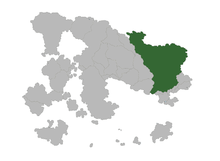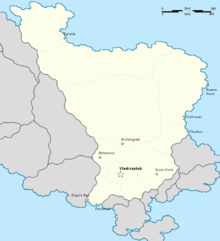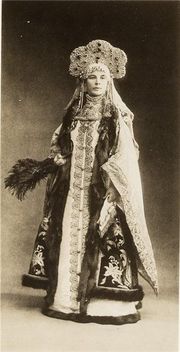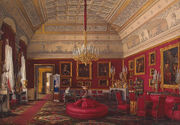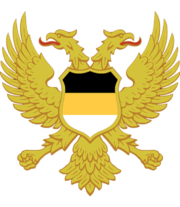Sibaria
| This page is a work in progress by its author(s) and should not be considered final. |
| The Sibarian Federation | |||||
|---|---|---|---|---|---|
|
|||||
| Motto: For our people | |||||
| Anthem: The State anthem of Sibaria | |||||
Map of Sibaria in Moneylania
|
|||||
Map of the various cities and Oblosks in Sibaria
|
|||||
| Capital | Vladivastak | ||||
| Largest | Petrevich | ||||
| Official languages | Sibarian, English | ||||
| Recognised national languages | Platacian, Xianuanise | ||||
| Ethnic groups (2025) | Sibarian, Platacian, Xianuanise | ||||
| Demonym | Sibarian | ||||
| Government | Federal semi-presidential constitutional republic | ||||
| - | President | Redovan Stojanovic | |||
| - | Prime Minister | Tutin Konstantin | |||
| Legislature | Parliament | ||||
| - | Upper house | Senate | |||
| - | Lower house | Assembly | |||
| Independent | |||||
| - | Ancient empire | 1,121 BCE | |||
| - | Formation of modern Sibarian states | 725 | |||
| - | Formation of Sibarian Empire | 1066 | |||
| - | Formation of USSR | 1921 | |||
| Area | |||||
| - | 804,060 km2 310,449 sq mi |
||||
| Population | |||||
| - | 2026 estimate | 190,183,912 | |||
| - | Density | 20/km2 51.8/sq mi |
|||
| GDP (PPP) | 2030 estimate | ||||
| - | Total | $6.88 trillion | |||
| - | Per capita | $36,175 | |||
| GDP (nominal) | 2030 estimate | ||||
| - | Total | $ 3.84 trillion | |||
| - | Per capita | $20,220 | |||
| Gini | 36.9 medium |
||||
| HDI | 0.88 very high |
||||
| Currency | Sibarian Pyvzik (PYV) |
||||
| Time zone | SNTS | ||||
| Date format | dd-mm-yyyy | ||||
| Drives on the | left | ||||
| Calling code | +2 | ||||
| Internet TLD | .sb | ||||
Sibaria (/S-eye bá'ría/ Sibarian: Sябиря) officialy The Sibarian Federation is a nation in Greater Moneylania, situated in the region known as Asumiqe. Sibaria is the largest nation in Moneylania at 804,060 km2. It borders D'nalop and Berkraine to the west and Reznovistan to the north-east. Sibaria is known for its technological advancements and economical power,
Tribes in the Sibarian region combined into an empire around early 3000 BC. They then dissolved in 725. The Sibarian Kingdom struck a deal with all of the other kingdoms in the area and formed the new Sibarian Empire in 1066, the start of the Medieval Era in Moneylania. The new empire had defeated the Xianuanese in 1152, at the Battle of Devonic Pine. Tsars and Tsarinas ruled The Sibarian Empire until the late the early 1900's, when a socialist revolution at the hand of Dorofei Yakovlev took over the monarchy and proclaimed himself head of state.
It is difficult to tell where the omnipresent, moralistic, socially-minded government stops and the rest of society begins, but it is effectively ruled by the Department of Law & Order, with areas such as Social Welfare and Religion & Spirituality receiving almost no funds by comparison. The average income tax rate is 47%, but much higher for the wealthy.
Crime is well under control, thanks to the all-pervasive police force. Sibaria's national animal is the Emu, which frolics freely in the nation's many lush forests, and its currency is the Sibarian Pyvzik.
Contents
History
Ancient Empire
The Sibarian Empire was formed sometime during 3,000 BCE and had begun expanding shortly after the founding of the empire. It suffered with long series of internal conflicts, conspiracies and civil wars from the late second century BC onward, while greatly extending its power beyond the Sibarian peninsula, all the way out towards Xianuan. There are also traces of Sibarian settlement in Troesil and Vasil. The 200 years that began with Emperor Vaskil's rule is traditionally regarded as the "Great Expansion". During this period, the cohesion of the empire was furthered by a degree of social stability and economic prosperity that Sibaria had never before experienced. Uprisings in the empire were infrequent, but put down "mercilessly and swiftly" when they occurred. The sixty years of Sibarian–Xian wars in the second half of the 1st century and the first half of the 2nd century were exceptional in their duration and violence.
Federation
Sibarian influence began to decline around 670 AD and continued to decline until the final civil war, the Great Sibarian War in 725 AD, ended what is now known as the Ancient Sibarian Empire. Small kingdoms ruled for about 300 years until the kings and queens of the Sibar Peninsula got together and formed the new Empire of Sibaria, with the king of the largest kingdom, Slakin Arkaeon, taking the role as Tsar.
The Sibarian Empire (1066-1923)
Arkaeon, the Grand Tsar of Sibaria was one of the most beloved of the medieval Sibarian rulers. His policy of open conflict with the Eternal Empire of Xianuan led to his assassination in Tskhinvali in 1056. His son Yonson Arkaeon succeeded him, and, concluding an alliance with the mighty Grand Duchy of Dnalop, managed to raise Sibarian prestige even higher and eventually defeated the Xianuanese in multiple battles.
After years of combat with the Xianuanese, the Dnalopish and Sibarians struck a deal in 1066 to formally induct Dnalop as a kingdom of the Sibarian Kingdom. They would still manage to have a king, but the Tsar had the final say. The Sibarian Empire was born. This new alliance inspired others to join suit. The Berkrainian Clans and the Kingdoms of Reznovi and Garganel signed deals the also inducted them into the Sibarian Empire. This inspired the creation of the Table of the Five Kings in 1121, after all kingdoms had become one.
During this time, the Five Kings had decided to focus internally. Their first decision was to officially form a Berkrainian kingdom. Years of building towns, cities, roads, equipment and farms had finally led to the establishment of the Berkrainian kingdom in 1145.
In 1152, the Xianuanese where officially defeated at the battle of Devonic Pine and the empire took control of the historical Nefilian Marshlands. This is the only land they took for more then two hundred years. Many Tsars ruled the empire leading into the 15 century. At the turn of the century, Sibaria had become a world force, having a powerful military, large navy, abundant resources, a large population and lots of land. The Tsar at the time, Garz Archeon (changing his last name to a more modern pronunciation of Arkaeon), had decided to focus on colonialism.
At first, attempts by the Sibarians to secure much land besides some islands off the coast where futile. This was until Tsar Boris Archeon, son of Garz and head of the Navy, issued the creation of ten new boats able to withstand the harshness of the Moneylanian Sea, a sea that not many have dared to cross. For years, people have stuck to the coast to trade, but in 1456, the new boats where put to use and they where a success.
Mikahel Gorbachov, head of the colonial unit and childhood friend of Boris, set out in 1478 looking to trade with Ironcastle and possibly find some land on the way. They where blown of course, however, spotted a previously unknown island. They set up camp on the island and sent a ship back to notify the Tsar of their discovery, named Daminy (Sibarian for "discovery").
In 1624, the Xianuanese had again taken land from the Sibarians in a surprise attack. Thus, prompted a large scale attack from the Empire. Many stories and songs came from this war, like the musical piece Overture 1624 by Tchaikovsky and O the lords attacked. In 1626, two years since the war started, the Dnalopish Winged Hussars had led the charge into Guanzow which led to the end of the war and the dissolution of the Xianuanese Empire. Many smaller kingdoms in Xianuan began to fight for control of the entire land.
Industrialisation
In 1803, the Empire began to industrialise with the discovery of coal in the northern tundras and the production of steel. With this newfound resource, production began to expand. With the discovery of coal and gold in Petrevich in 1808 began one of the biggest gold rushes in Moneylania, with people from all around Sibaria, Xianuan, Ironcastle and even all the way from Platacia began to enter the city.
Industrialisation was easy for the Empire, as each of the kings followed suit with Sibaria. Although Ironcastle is referred as the "center of technological innovation" during the 1800's, Sibaria wasn't too far behind, with it's economy expanding at a rapid pace. Petrevich became almost a secondary industrial capital, under Aelcrest and Gravida. The construction of rail lines and telegraph lines after 1870 allowed movement of people and ideas never seen before in the Empire. In the same period new systems were introduced, most significantly electrical power and telephones. At the closing of the 19th century, the Empire had expanded further into the northern tundras and gained oil deposits.
In 1902, Tsar Gregor II had issued the construction of tanks, naval ships and weaponry on a mass scale to improve it's military into it's former glory. By 1910, the navy had expanded to be one of the largest in the world again and the manpower behind the Sibarian troops was unprecedented. In August 1914, Sibaria declared war on Proagovania in response to it's invasion on the Asmeqe nations.
The Great War Period
THIS SECTION IS IN THE PROCESS OF BEING RE-WRITTEN, APOLOGIES FOR ANY INCONVENIENCE
Rise of Communism
The 1920s were an age of dramatic social and political change. Sibarian urban populations rose extremely. The nation’s total wealth more than tripled between 1920 and 1929, and this economic growth swept many Sibarians into an affluent but unfamiliar “consumer society.” People from coast to coast bought the same goods and listened to more music then ever before. However, many Sibarians were uncomfortable with this new, urban “mass culture”, in fact, for many people in Daminy, the 1920s brought more conflict than celebration, with the rise of Communism and the anti-Communist protesters. However, for a small handful of young people in the nation’s big cities, the 1920s were roaring.
In 1923, Dorofei Yakovlev had overthrown the Tsar and proclaimed an equal Yakovlev Socialist Society. This continued into the 30's where surprisingly, against the statistics of multiple regional analysts, Sibaria experienced an economic growth. Yakovlev had abolished unofficial slavery, meaning the government had to pay everyone an equal sum.
THIS SECTION ON WWII IS IN THE PROCESS OF BEING RE-WRITTEN, APOLOGIES FOR ANY INCONVENIENCE
Cold War
The Flazorians had been defeated and the Soviet flag raised over the Presidential House. However, the Sibarians had lost the most men in the war, with over 8 million soldiers killed and 10 million civilians killed. the industry in northern Sibaria had been destroyed, however the south was untouched. Petrevich, Keanor Point, Vladivastak and Slankov had an industry boom. New consumer products where being constructed for the people of Sibaria. The government issued free radios for households of those that fought in the war. However, some of those households had better quality radios, so they passed them down to the the poor. Prices for things such as clothing and food where now affordable for the average man, however, the poor had to rely on the generosity of the average man to survive.
The situation in Northern Sibaria was ignored until the beginning of the 50's. Tskhinvali was a safe haven for those that where affected by the war. Supplies were sent from other Soviet republics such as Dnalop to Tskhinvali to help with the sudden influx of people. While people lived a good life down south, those up north felt angered at the government's failure to do anything about it. In 1949, Sibaria had purchased multiple hundreds of farming and mining equipment from Xianuan to assist in the reconstruction of the former agricultural industry up north to a mining industry.
The 1950's was a time of growth, but also a time of suspicion. Numerous clashes with Ironcastle in terms of nuclear weapons and ideologies occurred which led to a bitter, cold war. Many proxy wars occurred, such as the Vasilian War, where the emergence of guerrilla warfare occured and the Kartofi Civil War. The Space Race was a race between Sibaria and Ironcastle in the 60's. Sibaria was winning the space race when they sent the first satellite into space, Spotmik I. They solidified their lead by sending the first man into space, Yusef Gregoria. With other feats such as sending the first woman in space and the first dog in space, they where ultimately defeated by the Ironians when they sent two men to the moon.
In the 70's the USSR had been experiencing a lowering economy. President Narziyabi had issued multiple economical reforms to bring up Sibarias economy to what it was multiple years ago, to no avail. At the turn of the decade, Narziyabi was replaced by Michael Polirovabic. Polirovabic was notable for attempting to bridge the divide between Sibaria and Ironcastle. Polirovabic wanted to mend relations so both nations could focus on more important things, such as terrorism. With terrorism on the rise in the early 80's, the United Sibarian Soviet Republics began to revamp it's military, beginning it's role as a major peacekeeping force. During the 80's, the USSR began an economic rise, with the production of newer technologies. The USSR had begun to station troops in areas such as Troesil to combat terrorism and began to trade with more nations.
Fall of the USSR - present
Narziyabi's decision to allow elections with a multi-party system and create a presidency for the USSR began a slow process of democratisation that eventually destabilised Socialist control and contributed to the collapse of the United Sibarian Socialist States. Following the elections on 21 January 1992, Polirovabic faced conflicting internal political pressures and the pluralist movement advocated democratisation and rapid economic reforms while the hard-line Communist elite wanted to thwart Narziyabi's reform agendas.
The unsuccessful December 1992 coup against Narziyabi sealed the fate of the USSR. Planned by the hard-line Communists, the coup diminished Narziyabi's power. Narziyabi eventually resigned his leadership as head of the Socialist party on the late hours of the 31 December 1992. The Soviet hammer and sickle was lowered for the final time at 9:23 PM and the Sibarian tricolour was raised shortly after. With the Chairman role extinct, Sibarian tricolour over the Krepost and the declaration of new republics, the USSR had ceased to exist.
Mass change occurred in the new state of Sibaria. One month into 1993, Narziyabi struck deals with the North Tskh Republic and the Republic of North Sibaira to form the Sibarian Federation. With this, he called the first Sibarian general elections for 1993. Gregory Renovic won the Sibarian elections of 1993, and with that, enacted new reforms to improve the state of the Sibarian economy. However, Sibaria's economy had diminished to almost half of its size under the USSR. This changed in 1998, when Renovic had signed an agreement in Stanata named the Stanata Concord, which was an economic agreement with the former USSR states that are now reforming capitalist societies.
At the dawn of the new millennium, Sibaria began to trade with nations in Central Moneylania, which allowed SIbaria's economy to expand. Sibaria continued to increase its economy, and eventually rose to its former status as a world power around 2022, under the DetWhiller administration with a GPD of USD $5 trillion. In 2026, Sibaria elected Redovan Stojanovic, who has been argued to be one of the greatest leaders of the new millennia, alongside those such as Saggio Uomo and Bradley Lister. Stojanovic had reformed the economy even more to increase it to it's current USD$7 trillion GDP, brought the War of Honour to a close, conducted anti-terrorist operations in Venisia and the Uzmorr Bay, the inception of a new Youthsville Pact and immensely improved relations with East Moneylania.
On the 6th of July 2031, skirmishes occurred on the Vasil-South Lukonian border which began the Sibarian-Lukonian War.
Geography and climate
Sibaria is diverse with different terrains, such as the northern tundras, southern steppes, central hills and the north-eastern forests. The climate of Sibaria is generally temperate. Sibaria's coastal areas are the most habitable, as shown by some of the larger cities located on the coast, namely Petrevich and Tskhinvali. The major mountain range, the Ryol Mountains, is one of the longest mountain ranges in the world and geographically splits the country into the warmer south and the colder north.
Economy
The Sibarian Federation has a regulated market economy. Based on market exchange rates, Sibaria has the second-largest economy in Moneylania, after Ironcastle. The national currency us the Pyvzik, one of the most traded currencies in the world.
Demographics
Ethnic Sibarians comprise 76% of the country's population. The Sibarian Federation is also home to multiple minorities. In all, 47 different other ethnic groups and indigenous peoples live within its borders, with a majority of them hailing from the north of the country. Though SIbaria's population is comparatively large, its density is low in the north due to the large population in the south. This is attributed to the economic positions of the former southern kingdoms compared to the north. Population is densest in Southern Sibaria, where five of the seven largest cities (Petrevich, Vladivastak, Slankov, Empire Bay and Keanor Point) being located in the south. 82% of the population lives in urban areas while 18% in rural ones.
Government
Sibaria is one of Moneylania's oldest civilisations, along with Platacia. It was also the oldest empire. Sibaria's parliament house is split into The Senate and The Assembly which both form the Sibarian Parliament. Sibaria ranks highly in human development lists, however, is constantly thought to be a semi-corrupt nation, despite Stojanovic's proven efforts to combat it.
Sibaria has four levels of government. They are Federal, Oblosk, Regional and Local. Oblosks (states) is made up of four regional areas (three for the Vladi Oblosk) and Regional is made up of five local governments.
Parties and Elections
Since the USSR dissolved, Sibaria has operated under a multi-party system, which have been dominated by three major parties and several minor parties. The two main parties in most states and the federal Senate are the Conservative-National Coalition and the Sibaria One Party. Members in the Oblosks are elected by those in that state, and same goes for Local. Regional governments do not have as much jurisdiction as local governments, but members for Regional government are chosen based on the amount of seats gained by a party in all five Local electorates.
Foreign Relations
Sibaria is a member of the Moneyzone, the Youthsville Pact and is a leader in peacekeeping forces. Nations in Moneylania have their embassies in the Moneylania District in Vladivastak (The embassy district named after the region, Moneylania).
Military
The Sibarian Armed Forces is the largest military in Moneylania, with over 1.3 million active and 2.2 million in reserve. The President of Sibaria also has the position of President of the Youthsville Pact, which gives them ultimate control over their respective armies. However, if a large majority (80%) of a respective nations parliament votes against military intervention in a specific nation, then the president does not get control of that nations military. The highest ranked officer of the Sibarian Armed Forces automatically is granted the role of Head of Defence/Defence Minister.
The Sibarian Combined Forces is split into two different groups.
Sibarian Armed Forces
The Sibarian Armed Forces is the main armed forces of Sibaria and deals with peacekeeping, invasions and defense.
- Sibarian Army - Operates on the ground (soldiers, ground based vehicals, etc)
- Sibarian Navy - Operates in the sea (destroyers, battleships, etc)
- Sibarian Air Force - Operates in the air (jets, bombers, etc)
- Sibarian Special Corps - A step up from the Sibarian Army, often sent on more dangerous missions.
- Sibarian Space Force - Operates in space, mostly with the re-arming of Observer and the emergence of space military technology.
Sibarian Special Forces
The Sibarian Special Forces is split into three different agencies, who each control men, weapons, vehicles and more on their own, in accordance to the President.
- Operation 40 (Op40) - The International Intelligence Agency that deals with heavy covert operations. (Operation 40 and C.O.O.K.S are the two groups that operate in the Op40)
- Voyska Navykov Agency (VNA) - International and Domestic Intelligence Agency that deals with light covert operations (Has the Voyska Navykov, the personal guards of the President and the presidents of the Youthsville Pact that operate in the Voska Navykov Agency)
- Sibarian Intelligence Bureau (SIB) - The Intelligence Agency tasked with international and domestic cyber defence, security and crime reduction.
Culture
Folk culture and cuisine
There are over 80 different ethnic groups and indigenous peoples in Sibaria. The country's vast cultural diversity spans ethnic Sibarians with their Sibarian Orthodox culture in the south, Reznovi and Gargi with their Turkic Nomadic culture in the west, the Lukosibar in the east, Shamanistic Durniski peoples of the extreme north, highlander Ryolia of the Ryol Mountains, and Judaic Shamania peoples of the Nalop borderlands.
Sibarian cuisine widely uses fish, poultry, vegetables and various natural mushrooms and herbs. Crops of rye, wheat, barley, and millet provide are used extensively as well, with Berkraine as its major importer and the western farmlands as a fertile region for growing such crops. Black bread is rather popular in Sibaria, compared to the rest of the world. Flavourful soups and stews have extensively been made in the Sibarian North as a way to warm up to the cold, while still being popular in the South.
Sibarian folklore is still ever present today, much of it being followed in the rather rural central lands and northern forest villages. A popular story told to kids is the story of Oggi Boogi, the night monster who would take away kids who misbehaved to their parents. Disappearances have been attributed to the story, mostly being disproven as the person in question returns after getting lost.
Art
Early Sibarian art has consisted of religious paintings and symbols, relating to the people's strong connection to their religion. As time moved forward, the Sibarian art identity began to take shape, culminating to the creation of a national arts centre in Vladivcastak in 1582. This gave Sibarian artists a platform to showcase their art to the nation and to the world, while allowing outside spectators to bask in the glory of the nations finest.
In the mid-19th century, a new group of artists broke from the National Insitute of Sibarian Art and Culture and its classical views on art and formed the National Salonski. These were mostly realist painters who captured Sibarian identity in showing the conditions of the poor and caricaturing authority. Some of these artists showed the Sibarian identity with realist paintings of rivers, cities and mountains. These artists where lauded by the common folk and pressured the now viewed as old National Insitute to incorporate them and give them a platform to showcase a new wave of Sibarian art. In 1863, the National Insitute finally caved in with the election of Vladimir Horish, a realist lauder, and incorporated the artists into the National Insitute. The Insitute decided to go one step furthut and host the National Salonski itself, continuing to showcase new and upcoming artists. Modern Sibarian art included neoplastisism, social-realism, expressionism, minimalism and supermatism.
Architecture
Music
Literature
Cinema
Sport
| ||||||||||||||||||||||||||||||||||||||||||||||||||||||||||||||||||||||||||


